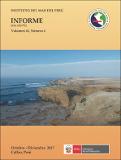Por favor, use este identificador para citar o enlazar este ítem:
https://hdl.handle.net/20.500.12958/3227Registro completo de metadatos
| Campo DC | Valor | Lengua/Idioma |
|---|---|---|
| dc.contributor.author | Espinoza Morriberón, Dante | - |
| dc.contributor.author | Ledesma Rivera, Jesús | - |
| dc.contributor.author | Colas, Francois | - |
| dc.contributor.author | Echevin, Vincent | - |
| dc.contributor.author | Anculle, Tony | - |
| dc.contributor.author | Tam Málaga, Jorge | - |
| dc.contributor.editor | Instituto del Mar del Perú | - |
| dc.date.accessioned | 2018-08-16T17:10:03Z | - |
| dc.date.available | 2018-08-16T17:10:03Z | - |
| dc.date.issued | 2017 | - |
| dc.identifier.citation | Inf Inst Mar Perú 44(4), 2017, p. 460-466 | es_ES |
| dc.identifier.issn | 03787702 | - |
| dc.identifier.uri | https://hdl.handle.net/20.500.12958/3227 | - |
| dc.description.abstract | Durante los años 2015-2016, se ha desarrollado en el Pacífico Central uno de los eventos El Niño (EN) más intensos de los últimos 50 años. Frente al sistema de afloramiento peruano este evento no tuvo los mismos impactos que otros EN extremos del Pacífico Central. El principal objetivo del estudio es describir y entender la evolución de las concentraciones de clorofila-a frente al sistema de afloramiento peruano. Se corrigieron los datos de MODIS respecto a SeaWIFS mediante un modelo aditivo generalizado y se obtuvo una serie de clorofila satelital desde setiembre de 1997 a la actualidad. Los resultados muestran que EN 2015-2016 presentó sus anomalías más negativas durante noviembre-diciembre 2015 sin llegar a compararse con otros EN extremos (1997-1998). Además, los otros EN también presentaron mayores anomalías negativas durante inicios de verano, lo cual se debería a mayor limitación de nutrientes durante esta estación. Las anomalías negativas se habrían producido debido al paso de una onda Kelvin cálida que profundizó la nutriclina, ocasionando menor concentración de nitratos y silicatos en superficie. Por último, se observaron anomalías positivas de viento sin embargo el afloramiento posiblemente se debilitó debido a una corriente zonal hacia la costa. | es_ES |
| dc.description.abstract | ABSTRACT: During the years 2015-2016, one of the most intense El Niño events in the last 50 years developed in the Central Pacific. Faced with the Peruvian upwelling system, this event did not have the same impacts as other extreme EN Pacific Central. The main objective of the study is to describe and understand the evolution of chlorophyll-a concentrations against the Peruvian upwelling system. The MODIS data were corrected for SeaWIFS through a generalized additive model and a series of satellite chlorophyll was obtained from September 1997 to the present. The results show that EN 2015-2016 presented its most negative anomalies during November-December 2015 without being compared with other extreme EN (1997-1998). In addition, the other ENs also showed higher negative anomalies during the beginning of summer, which would be due to greater nutrient limitation during this season. The negative anomalies would have occurred due to the passage of a warm Kelvin wave that deepened the nutriclina, causing a lower concentration of nitrates and silicates on the surface. Finally, positive wind anomalies were observed, however, the upwelling was possibly weakened due to a zonal current towards the coast. | - |
| dc.language.iso | spa | es_ES |
| dc.publisher | Instituto del Mar del Perú | es_ES |
| dc.relation.ispartofseries | Informe IMARPE;44(4), 2017 | - |
| dc.rights | info:eu-repo/semantics/openAccess | es_ES |
| dc.rights.uri | https://creativecommons.org/licenses/by/4.0/ | es_ES |
| dc.source | Instituto del Mar del Perú - IMARPE | es_ES |
| dc.source.uri | Repositorio Digital IMARPE | es_ES |
| dc.subject | Fenómeno El Niño | es_ES |
| dc.subject | Afloramiento peruano | es_ES |
| dc.subject | Oceanografía física | es_ES |
| dc.subject | Clorofila | es_ES |
| dc.title | Productividad en el sistema de afloramiento peruano durante El Niño 2015-2016 | es_ES |
| dc.title.alternative | Productivity in the Peruvian upwelling system during the El Niño 2015-2016 | es_ES |
| dc.type | info:eu-repo/semantics/article | es_ES |
| Aparece en las colecciones: | Informe vol. 44(4) 2017 | |
Ficheros en este ítem:
| Fichero | Descripción | Tamaño | Formato | |
|---|---|---|---|---|
| Informe 44(4)1.pdf | Productividad ... | 39 MB | Adobe PDF |  Visualizar/Abrir |
Este ítem está sujeto a una licencia Creative Commons Licencia Creative Commons

